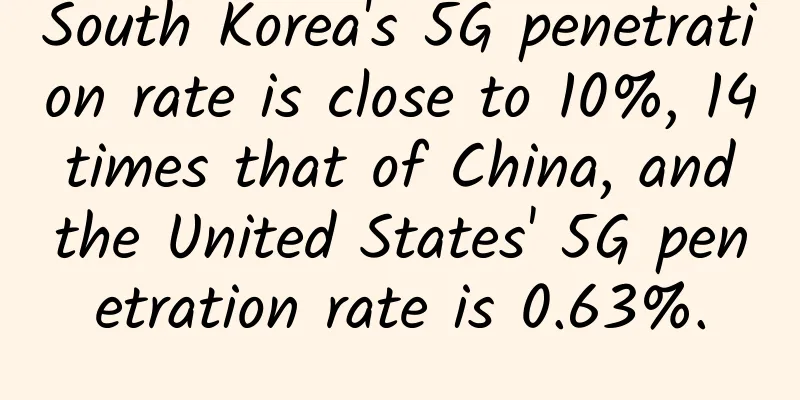South Korea's 5G penetration rate is close to 10%, 14 times that of China, and the United States' 5G penetration rate is 0.63%.

|
The Ministry of Science and ICT of South Korea recently released the South Korean 5G report. In the wave of 5G commercialization, South Korea is at the forefront. They are the first country in the world to launch 5G commercial services, and currently the penetration rate of 5G ranks first in the world.
South Korea officially launched 5G commercial services on April 3 last year. At that time, the three major telecom operators SK Telecom, KT and LG Uplus launched 5G commercial services for individual consumers. By the end of last year, the number of 5G users had reached 5 million. The current new data is 5.77 million. There are 115,000 5G base stations nationwide. Both data are second only to China. As early as December 1, 2018, they began to provide 5G services to corporate users. In terms of 5G penetration rate, South Korea is far ahead of other countries. At the beginning of this month, South Korea's 5G penetration rate had reached 9.67%, close to 10%. In comparison, the United States, which launched 5G commercial services shortly after South Korea, currently has a penetration rate of 0.63%. The United Kingdom, which began commercial use in May last year, has a 5G penetration rate of 0.56%. China's 5G penetration rate is 0.69%, and South Korea's 5G penetration rate is 14 times that of China. Foreign media reported that South Korea's 5G penetration rate is far ahead of the world, largely due to the heavy investment of telecom operators. To promote the popularization of 5G, the three major Korean telecom operators, SK Telecom, KT and LG Uplus, significantly increased their capital expenditure last year to 8.08 trillion won (about US$6.658 billion), a year-on-year increase of 60%. South Korea's telecom operators have also decided to increase investment in 5G network construction in the first half of this year, from the previously planned 2.7 trillion won to 4 trillion won (about US$3.296 billion), an increase of nearly 50%. In addition, Korean telecom operators also plan to expand the coverage of indoor 5G base stations and install 5G base stations in about 2,000 locations such as subways, airports, and shopping malls. |
<<: 5G base stations, intelligent energy storage system is the key
>>: Growth in remote work demands solutions to unified communications infrastructure issues
Recommend
Operators’ worries: 4G die-hards unwilling to upgrade and “move”
Are you a 4G die-hard who is unwilling to move? I...
Where does the power of high-performance 5G core network come from?
The core network is the brain of the entire commu...
Are driverless cars, smart homes, telemedicine, etc. all dependent on 5G?
1. As for the reason why 5G was over-promoted bef...
Kvmla: Hong Kong/Japan/Singapore VPS hosting 20% off from 60 yuan/month, top up 500 yuan and get 100 yuan free, Singapore dedicated server from 350 yuan/month
The old merchant kvmla is currently carrying out ...
What’s next after the first 5G standard is released?
On June 14, Beijing time, the International Mobil...
Building "China's Most Secure Cloud"! Huawei Cloud Passes the Most Stringent PCI-DSS Security Certification in History
[51CTO.com original article] On March 22, Huawei ...
Huawei China ICT Ecosystem Tour 2018 successfully concluded, calling on partners to create a prosperous ecosystem
[Original article from 51CTO.com] From late sprin...
AlphaVPS: VPS hosting with large hard disk starts from €15/year, AMD EPYC/Ryzen starts from €2.99/month
AlphaVPS was founded in 2013 and is a leading Iaa...
DMIT: Los Angeles 1-10Gbps high bandwidth CN2 GIA line VPS quarterly payment starts from $28.8
DMIT.io is a foreign hosting company founded in 2...
Liu Liehong: my country has built the world's largest optical fiber network and 4G network
[[391129]] On March 31, the "2021 Digital Tr...
Yike Cloud: 20% off on all VPS hosts, US CN2 GIA/Hong Kong CN2/CN2 High Defense lines available
OneTechCloud is a Chinese business founded in 201...
Network communication and governance, who is better? Comparison of Envoy and Nginx at the architectural level
[[281978]] Nginx was a very representative open s...
As 5G price war begins, US operators also adopt "Internet thinking"
After taking the lead in the world in 5G network ...
5G landscape changes dramatically: Apple and Qualcomm reach a settlement, Intel withdraws its votes and leaves, Huawei remains unscathed
Overnight, 5G changed the world. First, Qualcomm ...









